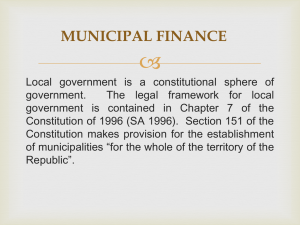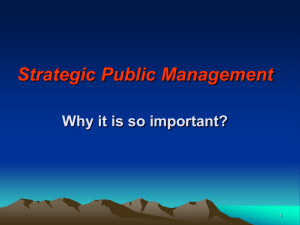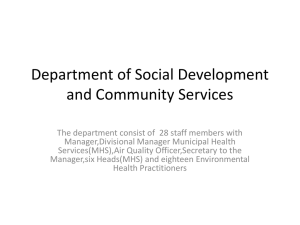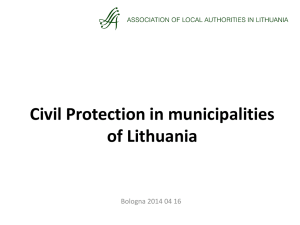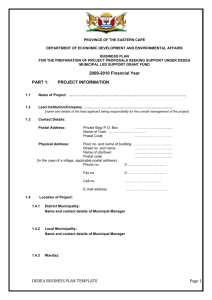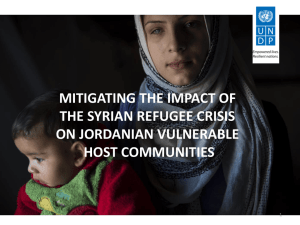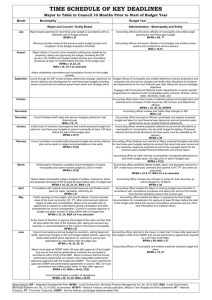Minimum Business Process Requirements - Draft Version 1
advertisement
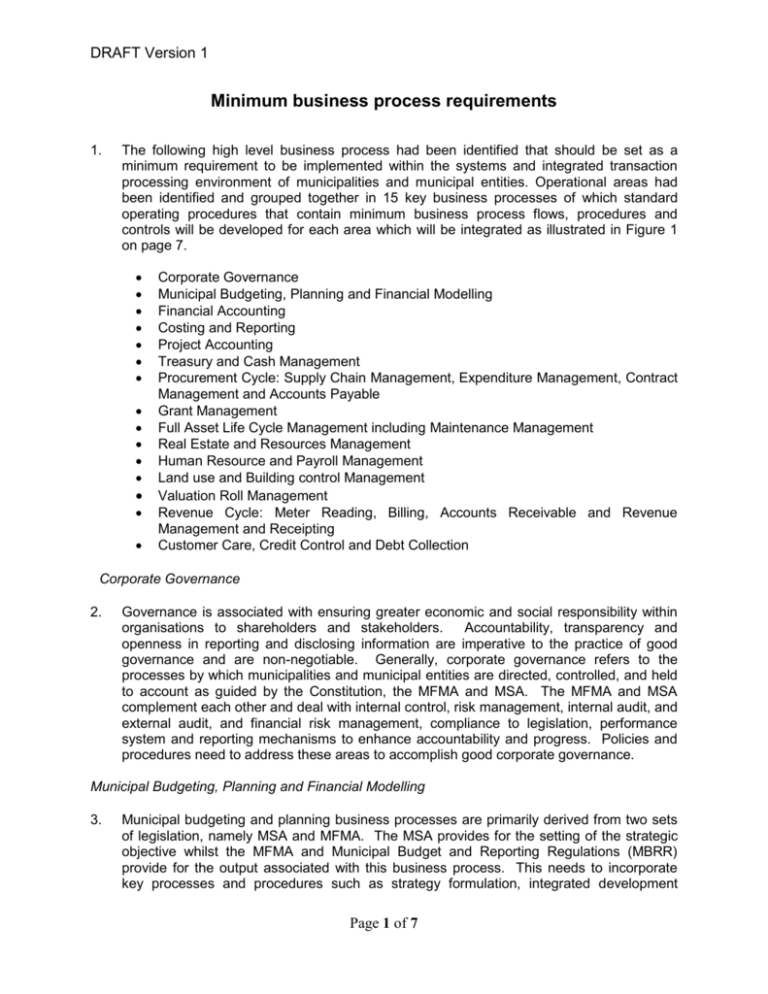
DRAFT Version 1 Minimum business process requirements 1. The following high level business process had been identified that should be set as a minimum requirement to be implemented within the systems and integrated transaction processing environment of municipalities and municipal entities. Operational areas had been identified and grouped together in 15 key business processes of which standard operating procedures that contain minimum business process flows, procedures and controls will be developed for each area which will be integrated as illustrated in Figure 1 on page 7. Corporate Governance Municipal Budgeting, Planning and Financial Modelling Financial Accounting Costing and Reporting Project Accounting Treasury and Cash Management Procurement Cycle: Supply Chain Management, Expenditure Management, Contract Management and Accounts Payable Grant Management Full Asset Life Cycle Management including Maintenance Management Real Estate and Resources Management Human Resource and Payroll Management Land use and Building control Management Valuation Roll Management Revenue Cycle: Meter Reading, Billing, Accounts Receivable and Revenue Management and Receipting Customer Care, Credit Control and Debt Collection Corporate Governance 2. Governance is associated with ensuring greater economic and social responsibility within organisations to shareholders and stakeholders. Accountability, transparency and openness in reporting and disclosing information are imperative to the practice of good governance and are non-negotiable. Generally, corporate governance refers to the processes by which municipalities and municipal entities are directed, controlled, and held to account as guided by the Constitution, the MFMA and MSA. The MFMA and MSA complement each other and deal with internal control, risk management, internal audit, and external audit, and financial risk management, compliance to legislation, performance system and reporting mechanisms to enhance accountability and progress. Policies and procedures need to address these areas to accomplish good corporate governance. Municipal Budgeting, Planning and Financial Modelling 3. Municipal budgeting and planning business processes are primarily derived from two sets of legislation, namely MSA and MFMA. The MSA provides for the setting of the strategic objective whilst the MFMA and Municipal Budget and Reporting Regulations (MBRR) provide for the output associated with this business process. This needs to incorporate key processes and procedures such as strategy formulation, integrated development Page 1 of 7 DRAFT Version 1 planning, prioritisation, revenue generation, resource allocation, as well as long term forecasting and modelling of key financial dimensions such as the statement of financial position, cash flow forecasting, funding compliance, asset management and basic service delivery. Financial Accounting 4. Financial accounting incorporates a host of policies, processes and procedures in order to operationalise the effective and efficient recording and accounting of daily financial transactions as well as month and year end closure procedures and transactions. The MFMA provides a platform for the prescription of norms and standards such as the Standards of Generally Recognised Accounting Practices (GRAP) which have been designed and formulated based on unique South African circumstances (such as the VAT requirements which must be accommodated by the financial system) and leading international practices. Municipalities and municipal entities are therefore required to operationalise daily business processes and procedures that incorporate at the very least regular reconciliations, correct and accurate allocation and classification of transactions based on the SCOA classification framework. These processes and procedures must give rise to monthly performance represented by among others, the Statement of Financial Performance, Capital and Grant Performance, Statement of Financial Position, movement in net assets and cash flow in the Section 71 in-year reporting formats. It is important to keep in mind that outputs needs to be reported and must at all times be measurable so that progressive achievements can benefit communities. Processes should be focussed at clean and accountable operations and the outcome must be reported in terms of by all roll players. Costing and Reporting 5. Costing or management accounting is concerned with financial and management information internal to the municipality and municipal entity which provides the basis for sound and informed business decision making. In contrast to financial accounting, management accounting is primarily forward looking instead of historically focused and informs planning and budget processes by applying forecasting and prediction models. Determining the full cost of tariff services including primary and secondary costing to inform tariffs and pricing of services in order to achieve cost reflective tariffs, reporting thereon and measuring performance of services based on financial and non-financial information. Project Accounting 6. Project Accounting refers to the capability to account for individual project costs and ensure that these settle as assets under construction (AUC’s) where applicable. The project accounting functionality should be extendable to provide project management capabilities in order to track physical project progress against predetermined milestones in addition to tracking the financial performance of the project or portfolio of projects. Page 2 of 7 DRAFT Version 1 Treasury and Cash Management 7. Treasury and cash management refers to investing, financing activities and operational cash management. The following processes must be considered relevant to this cycle – (a) Investing activities comprises the acquisition, disposal and management of tangible assets, including land, buildings, plant and machinery, motor vehicles, furniture and equipment, computer hardware, software and communication networks. Also included are acquisition, disposal and management of intangible assets such as research and development expenditure, patents and trademarks, scientific and technical know-how, intellectual property rights such as copyrights and licences. Municipalities and municipal entities must introduce accounting policies for depreciation, impairment, revaluation, asset retirement, etc; (b) Financing activities are the means by which the municipality or municipal entity obtains its funding. This may be in the form of funds obtained from borrowing (external loans) or transfers and subsidies to the municipality or municipal entity. Financing activities also include finance and operating leases entered into by the municipality or municipal entity. Included are related transactions such as security and guarantees granted to a lender, accounts receivables pledged to a discount house, interest charges, finance charges on leases, foreign exchange gains and losses, hedging gains and losses and commitments for capital expenditure; (c) Investment may take the form of fixed interest, long-term or short-term debt, investments or loans; secured or un-secured. Procedures must be implemented to control the purchase and sale of investments, the movement of scrip or recording of dematerialised securities and the resulting cash received and paid including income from investments, and (d) Cash and bank refers to transactions occurring daily in all municipalities and municipal entities represented by a high volume of transactions in payments and receipts. Procedures must provide for expenses and reimbursements of “imprest accounts and floats” including regular surprise counts; cash handling procedures for unbanked receipts and money in transit; control over the opening of bank accounts and obtaining access to electronic banking signatures, regular reconciliations of bank accounts and timely follow-up of reconciling items by management. Procurement Cycle - Supply Chain Management, Expenditure Management, Contract Management and Accounts Payable 8. Supply Chain Management, Expenditure Management and Accounts Payable (Creditors) needs to incorporate as a minimum the following – (a) Supply chain management is the management of a network of interconnected business processes involved in the provision of goods and services required by the municipality. It integrates the management of supply, demand, acquisition, logistics and disposal by implementing a supply chain management policy in compliance with the MFMA in a fair, equitable, transparent, competitive and cost effective way; (b) Expenditure management follows the SCM processes that should ensure an effective system of expenditure control, including procedures for the approval, authorisation, withdrawal and payment of funds. These expenditures should be monitored against the approved budget, and reasons for variances must be explained and corrective action must be implemented to keep expenditure in line with budget estimates; Page 3 of 7 DRAFT Version 1 (c) Accounts payable results from any monies owed in respect of goods and services purchased and must be settled within thirty days of date of invoice or statement unless it is prescribed otherwise. The payment of creditors or accounts payable must be reconciled monthly according to the statements received from service providers; (d) Material and inventory management deals with the maintenance of inventory catalogues classified according to the high-level categories provided for in the Standard Chart of Accounts. Business processes need to incorporate at a minimum, ordering; issuing and management of inventory levels; preferred suppliers linked to inventory categories; flagging of stock levels with limited movements for substantial periods; regular physical counts and reconciliation to system stock records; exception reporting and enhanced controls on stock items susceptible to misuse such as illegal stock-pilling; and all sub stores to be activated on the system; (e) Contract management entails the management of contracts through the entire Contract Life Cycle so as to maximise value for money that includes procedures for planning; contract creation; collaboration; execution; administration; and closeout. Contracts should be listed in a contract register embedded into the financial application that automats all the activities necessary to manage the contract as informed and dependant on the nature of the work, the type of contract, the legal aspects and delivery timeframes. It also entails the activities carried out to determine whether the service provider and the municipality are performing adequately to meet the requirements in listed contracts that had been awarded through the procurement process and the prescriptions in the MFMA; and (f) Vendor management entails managing a supplier database in support of various strategic procurement objectives. Grant Management 9. Grant management includes all the activities, processes and procedures to register and reconcile all the grants allocated, received and spent according to the conditions in the annual Division of Revenue Act. Full Asset Life Cycle Management including Maintenance Management 10. In terms of Section 152 of the Constitution local governments primary mandate is to ensure services are provided in a sustainable manner; this notion and spirit is supported by the MFMA. Good asset management facilities the provision of services in a financially sustainable manner requiring adequate automation of critical process within the asset management cycle. Typical to an effective and efficient system at least the following functions need to be addressed by the minimum business process requirements – (a) (b) (c) (d) (e) (f) (g) Safeguarding of assets, e.g. asset tracking, numbering and locations; Maintaining assets, planned and unplanned maintenance which needs to also incorporate capital asset renewal; Maintenance costing as an input into asset replacement plans; Establishing and maintaining a management, accounting and information system that accounts for the assets of the municipality; Asset valuation principles in accordance with Generally Recognised Accounting Practice; Establishing and maintaining systems of internal controls over assets; Establishing and maintaining asset register; Page 4 of 7 DRAFT Version 1 (h) Clarifying responsibilities and accountabilities for the asset management process, and (i) Insurance of assets. Real Estate and Resource Management 11. Real estate management includes the management of land plus anything permanently fixed to it, including buildings, sheds and other items attached to the structure that are both lease-in and lease-out. It can be grouped into three broad categories based on its use residential, commercial and industrial. Examples of real estate include undeveloped land, houses, condominiums, town homes, office buildings, retail store buildings and factories. Specific attention needs to be given to the property register inclusive of owned and leasehold properties, tenant and occupant information, lease contract administration and management, occupational health and safety requirements, insurance, etc. Other resources management among others include fleet (vehicle) management, plant and equipment, etc including the hiring thereof. Human Resource and Payroll Management 12. Human resources and payroll management is the organisational function that deals with issues related to employees such as compensation, hiring, performance management, organisational development, safety, wellness, leave management, benefits, employee motivation, communication, administration, and training in line with the prescriptions of the Labour Relations Act. Staff establishment, human resources development and expenditures on staff benefits should be done according to the processes and procedures set out in the MSA and MFMA. Pay roll management entails the administration of the financial record of employees' salaries, wages, bonuses, net pay, and deductions and should be done within the limits of the approved budget and the prescriptions of the South African Revenue Services. Budgeted remuneration and benefits needs to be directly aligned to the approved staff establishment with provision for vacancies shown separately and all staff payments must be reconciled monthly. The issue of productivity or performance management needs to be addressed by using the latest available technologies such as bio metrics devices Land use and Building Control Management 13. Land use management is a process of managing the use and development of land. Aspects need to include spatial; urban policy usage, and economic considerations. A land use management system need to include all processes, methods and tools used for organising, operating and supervising the urban environment including the factors influencing it. A management system needs to cover all phases from the vision behind the preparation of plans and decisions to their implementation and the monitoring of impacts. Planning practices, decision making processes, procedures, implementation, monitoring mechanisms, methods and tools used in the above-mentioned phases are all elements of an integrated system. In general, land use management is driven by various decisions taken at different levels of administration (local, regional, national). Building management incorporates all activities relating to township management such as building plan approvals, rezoning applications, illegal land usage and by-laws management. Importantly, the land and building management needs to be integrated with the revenue value chain of the municipality. Page 5 of 7 DRAFT Version 1 Valuation Roll Management 14. The valuation roll forms the basis for the levying of assessment rates and all processes and procedures are governed by the Municipal Property Rates Act. All categories of properties in the municipal boundary need to be recorder and maintained in a municipal register of properties including the value of land and improvements as described in the MPRA. Municipalities are also required to undertake interim valuations to ensure the roll is constantly maintained and updated. Importantly, the business processes need to ensure integration with the revenue value chain of the municipality and the billing processes and procedures. Revenue Cycle - Meter Reading, Billing, Accounts Receivable and Revenue Receipting 15. Efficient and effective systems of revenue management are necessary to enable the municipality to collect all monies due in respect of the common sources of revenue such as property tax, electricity, water, sanitation and solid waste management as required by the MSA and MFMA. Business processes that integrate the revenue value chain must be closely examined so that improvements can be made to ensure an efficient and effective utility, property, real estate and sundry billing and revenue collection function; data integrity for metered services and assessment rates is critical to ensuring the accuracy of the statement or account presented to the customer. Water and electricity meters must be read on a monthly basis and processes and procedures implemented to ensure that estimates are limited to the minimum. Monthly statement of payables must be distributed accurately and on-time to customers and payment facilities in terms of location of pay points and the payment options must be made available to the customers. Processes and procedures must be implemented to ensure sufficient internal control over the collection and receipting of revenue and daily reconciliation thereof. Customer Care, Credit Control and Debt Collection 16. Each municipality must within its financial and administratively capacity establish a sound customer management system as prescribed in the MSA. Credit control and debt collection is the responsibility of the municipality and processes, procedures and mechanisms must be implemented in line with the policy as adopted by the Council as prescribed in the MSA. 17. Some other miscellaneous business processes might be required by municipalities and municipal entities not detailed in the high level business processes above. These business processes to be continued as required by the municipality or municipal entity. Page 6 of 7 DRAFT Version 1 Figure 1 Integrated high level municipal business processes GOOD GOVERNANCE – INTERNAL CONTROL – ACCOUNTABILITY – TRANSPARENCY – COST EFFECTIVENESS – EFFICIENCY – PRODUCTIVITY - COMPLIANCE INTEGRATED HIGH LEVEL MUNICIPAL BUSINESS PROCESSES PLANNING IMPLEMENTATION EVALUATION Service Delivery and Budget Implementation Plan (SDBIP) Valuation Roll Management Capital Project Prioritisation Model CRM - Accounts Receivable - Receipting - Customer Care - Credit control - Debt Collection Internal Audit Treasury & Cash Management IDP Planning Process - Analyses - Strategies - Projects - Integration - Approval - Review REVENUE CYCLE - Meter Reading - Billing Performance Management Budget Process 3 Year Medium Term Capital and Operating - Bank - Investments - External Loans Financial Accounting Reporting (General Ledger) Financial Statements Human Resources & Pay Roll Long term forecasting - Business plan - Investment Plan - Funding plan - Tariff modelling PROCUREMENT CYCLE - SCM - Expenditure - Accounts Payable Grant & Contract Management COSTING Management Accounting External Audit LOGISTICS & SERVICE DELIVERY CYCLE - Asset and Maintenance Management - Real Estate Management - Land and Building control Management - Project Management - Resource Management (Fleet, Plant & Equipment, etc.) Page 7 of 7 Risk Management (Insurance) A N N U A L R E P O R T
